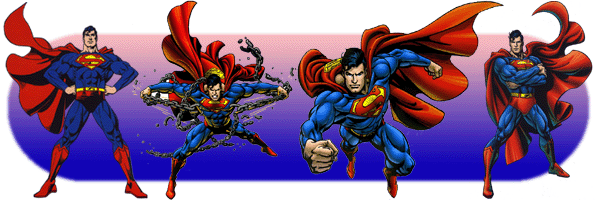|
|
||||||||||||
|
In those days, you could easily draw a line connecting all the major Superman artists in a neat, orderly fashion. The "line" began, of course, with Superman's artistic creator Joe Shuster. Then, Wayne Boring emerged from Shuster's shop full of assistants to become the Superman artist of the 50s. Curt Swan, in turn, arrived to take some of the load from Boring and ended up as top dog in the 60s. Now here we were in the 70s, with a new artist on the scene to help out Curt. This "new kid on the block" had a graceful, elegant style we were sure was the next step in the Man of Steel's evolution. Surely, Jose Luis Garcia-Lopez would be "The Artist of Tomorrow." Alas, it was not to be, but for a few terrific years there the future looked very bright for old Supes, as Garcia-Lopez crafted his adventures with just the right blend of tradition and innovation. Judging from the youthful energy and vitality of his art, it seemed natural to assume this "new kid" literally was a kid, but the truth is Garcia-Lopez was close to 40 years old when he came to the Superman books, and had more than paid his dues as an illustrator. Born in Spain in 1948, he had moved to Argentina as a child and by 1962 was enrolled in a private art school. He entered the American comics scene in the late 60s, providing art for Charlton Comic's mystery books. A 1974 meeting with editor Joe Orlando brought him his first assignments for DC Comics, and soon he was working on Superman, Batman, Hawkman, Tarzan and Jonah Hex stories and covers. A talented draftsman who counted Alex Raymond and Hal Foster among his influences, Garcia-Lopez shared their mastery of human anatomy and elegant composition. His superheroes were athletic, sinewy figures who seemed quite capable of the daring acts demanded of them. His Superman was less muscular than Kirby's and more limber than Swan's. This Man of Steel's physique suggested the all-around fitness of an Olympic decathlete rather than the husky heft of a circus strongman. Moreover, this Superman looked young, as much as ten years younger than the benevolent father figure Swan and his imitators drew. Not so young, however, that he lost credibility as a full-grown hero. In fact it would be fair to say that what Garcia-Lopez brought to Superman was sex appeal. For the first time in decades, Kal-El was all about youthful athleticism and raw energy. Wizard magazine once described the Garcia-Lopez Superman as a dead ringer for Christopher Reeve. Frankly, I never saw much resemblance, but I will allow that if you accept Swan's Superman as the George Reeves model (fatherly, protective and all-knowing), then Garcia-Lopez provided the Christopher Reeve version (younger, virile and more emotional).
Garcia-Lopez provided art on numerous Superman stories, but for the most part he remained a "fill-in" artist, stepping in for the odd stand-alone issue while Curt Swan churned out the art for the vast majority of Action and Superman stories. There were some high-profile special assignments, however, like the tabloid-sized Superman vs. Wonder Woman. Designed to capitalize on the popularity of the Wonder Woman TV show, the story was set in World War II, despite the fact that Garcia-Lopez drew Superman in his "Earth-1" configuration (for those too young to remember, the Earth-1 Supes would have been a baby -- or not even born -- during the war). In fact, there was an "alternate universe" feel to the whole thing, but the chance to see Garcia-Lopez work his magic on two of DC's "big three" was irresistable. The story introduced Nazi villain Baron Blitzkreig, later to figure in the All-Star Squadron series of the 1980's. The Baron gave Superman a run for his money in this story, with Garcia-Lopez using the enlarged, tabloid format to great effect in numerous slam-bang fight scenes.
If there was ever any truth to my theory that Superman artists ascended to the throne via "royal succession", it became a moot point in 1986, when the monarchy itself was overthrown with DC's infamous Superman "re-boot." The Man of Steel was re-imagined by (then) superstar artist John Byrne, who took a wholly different direction from Garcia-Lopez (though he did set out to make Superman even younger and more sexy than ever). In Byrne's wake, art on the Superman books has turned for inspiration to the Marvel style and, of all things, to Japanese manga. But lest you think Garcia-Lopez and his traditional illustrative style were rendered obsolete, consider this: after almost 20 years, his renditions of Superman not only continue to serve as an in-house "style sheet" for DC artists, but also account for spot illustrations for magazine ads, buttons, and t-shirts, plus packaging art for merchandise from coloring books to lunch boxes to peanut butter.
In fact, even though he missed out on his "destiny" to become chief artist on the Superman books, the images of Superman that have been most viewed and recognized around the world for two decades now have been images created by Jose Luis Garcia-Lopez. Thanks to him, Superman is still looking good after all these years. And you know what? Old blue still doesn't look a day over 29.
|
This fan-run web-site is neither authorized nor endorsed by DC Comics, Warner Brothers, nor the Siegels. 'Superman' and 'Supermen of America' are TM DC Comics, 'Superman'� DC Comics, Joanne Siegel, and Laura Siegel Larson. Superman created by Jerry Siegel and Joe Shuster. CLICK HERE to visit the official Superman site. |

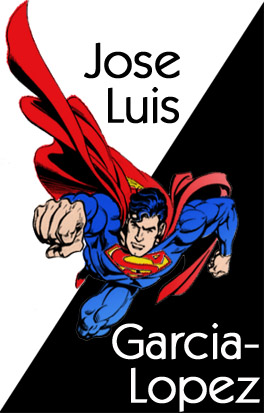 Back in the late 70s, we thought we
knew where Superman art was headed.
Back in the late 70s, we thought we
knew where Superman art was headed. 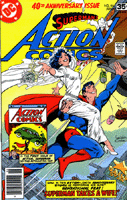
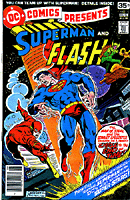
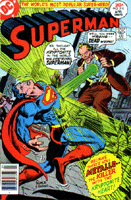

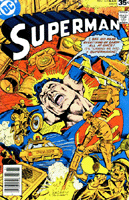
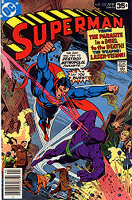
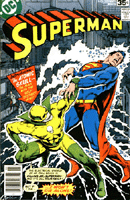
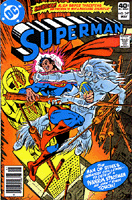
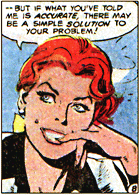 Superman's
supporting cast benefited from the new art style, as well. Lois
Lane and Jimmy Olsen took on trim, handsome new looks to match the
Man of Steel's. Just about everyone got better looking, but my personal
favorite was Dr. Jenette Klyburn, a high-ranking scientist
at STAR laboratories whom the writers occasionally toyed with making
into a love interest for Supes. With Garcia-Lopez on the art chores,
Jenette graduated from another stock Swan female into a spectacular
bombshell. With her green eyes and red hair, she provided a nice
visual contrast to brunette Lois, and her scientific background
suggested a brain behind the pretty face, unlike a certain pair
of long-time girlfriends who had proved themselves hopeless ninnies
time and again.
Superman's
supporting cast benefited from the new art style, as well. Lois
Lane and Jimmy Olsen took on trim, handsome new looks to match the
Man of Steel's. Just about everyone got better looking, but my personal
favorite was Dr. Jenette Klyburn, a high-ranking scientist
at STAR laboratories whom the writers occasionally toyed with making
into a love interest for Supes. With Garcia-Lopez on the art chores,
Jenette graduated from another stock Swan female into a spectacular
bombshell. With her green eyes and red hair, she provided a nice
visual contrast to brunette Lois, and her scientific background
suggested a brain behind the pretty face, unlike a certain pair
of long-time girlfriends who had proved themselves hopeless ninnies
time and again.  Eventually
Garcia-Lopez found a home of sorts in the pages of DC Comics
Presents. In case you missed it, DCCP was to Superman
what Brave and the Bold was to Batman; a place for Superman
to interact, on a monthly basis, with the various characters of
the DC Universe, from the obvious (Green Lantern, Hawkman, the Flash)
to the unlikely (Sgt. Rock, OMAC, Swamp Thing) to the downright
strange (the Joker, the Legion of Substitute Heroes and...Clark
Kent?). Garcia-Lopez provided terrific art for many issues in the
early part of the book's run, most notably the first two issues
guest-starring the Flash (with inks by Dad Adkins) and a splendid
team-up with Deadman in issue 24. He inked his own pencils on this
issue with terrific results, but unfortunately, his others inkers
were a mixed bag, so that some of the tales (the Joker story springs
to mind) turned out pretty awful.
Eventually
Garcia-Lopez found a home of sorts in the pages of DC Comics
Presents. In case you missed it, DCCP was to Superman
what Brave and the Bold was to Batman; a place for Superman
to interact, on a monthly basis, with the various characters of
the DC Universe, from the obvious (Green Lantern, Hawkman, the Flash)
to the unlikely (Sgt. Rock, OMAC, Swamp Thing) to the downright
strange (the Joker, the Legion of Substitute Heroes and...Clark
Kent?). Garcia-Lopez provided terrific art for many issues in the
early part of the book's run, most notably the first two issues
guest-starring the Flash (with inks by Dad Adkins) and a splendid
team-up with Deadman in issue 24. He inked his own pencils on this
issue with terrific results, but unfortunately, his others inkers
were a mixed bag, so that some of the tales (the Joker story springs
to mind) turned out pretty awful.